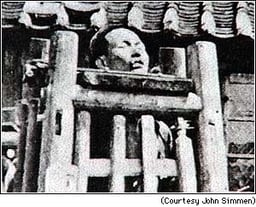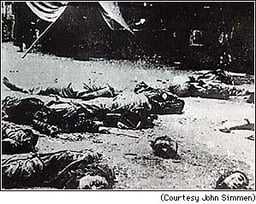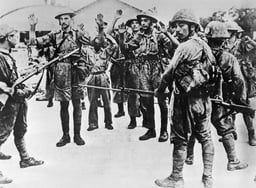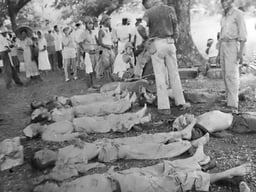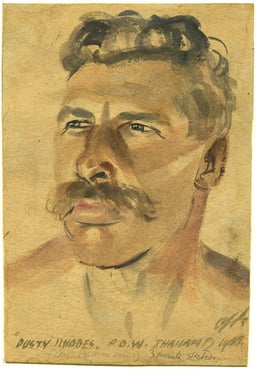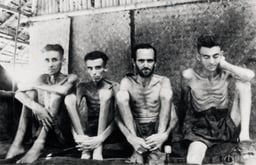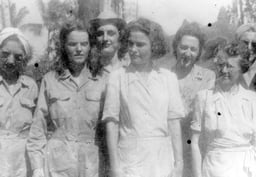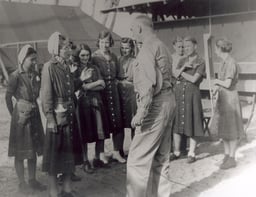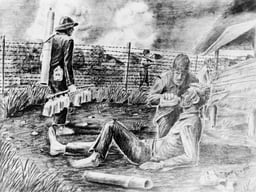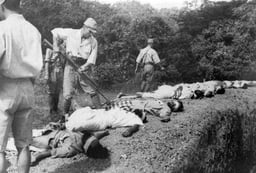Prisoner of war
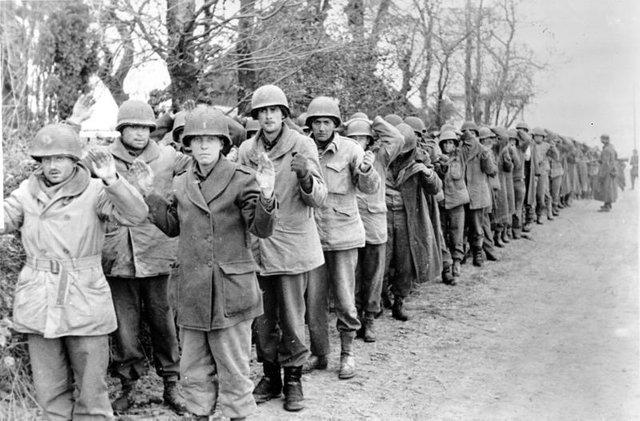
Prisoner of war
A prisoner of war (POW) is a person, whether a combatant or a non-combatant, who is held captive by a belligerent power during or immediately after an armed conflict. The earliest recorded usage of the phrase "prisoner of war" dates back to 1610.[1]
Belligerents hold prisoners of war in custody for a range of legitimate and illegitimate reasons, such as isolating them from enemy combatants still in the field (releasing and repatriating them in an orderly manner after hostilities), demonstrating military victory, punishing them, prosecuting them for war crimes, exploiting them for their labour, recruiting or even conscripting them as their own combatants, collecting military and political intelligence from them, or indoctrinating them in new political or religious beliefs.[2]
Ancient times

Engraving of Nubian prisoners, Abu Simbel, Egypt, 13th century BC
For most of human history, depending on the culture of the victors, enemy combatants on the losing side in a battle who had surrendered and been taken as prisoners of war could expect to be either slaughtered or enslaved.[3] Early Roman gladiators could be prisoners of war, categorised according to their ethnic roots as Samnites, Thracians, and Gauls (Galli).[4] Homer's Iliad describes Greek and Trojan soldiers offering rewards of wealth to opposing forces who have defeated them on the battlefield in exchange for mercy, but their offers are not always accepted; see Lycaon for example.
Typically, victors made little distinction between enemy combatants and enemy civilians, although they were more likely to spare women and children. Sometimes the purpose of a battle, if not of a war, was to capture women, a practice known as raptio; the Rape of the Sabines involved, according to tradition, a large mass-abduction by the founders of Rome. Typically women had no rights, and were held legally as chattels.[5]
In the fourth century AD, Bishop Acacius of Amida, touched by the plight of Persian prisoners captured in a recent war with the Roman Empire, who were held in his town under appalling conditions and destined for a life of slavery, took the initiative in ransoming them by selling his church's precious gold and silver vessels and letting them return to their country. For this he was eventually canonized.[6]
Middle Ages and Renaissance
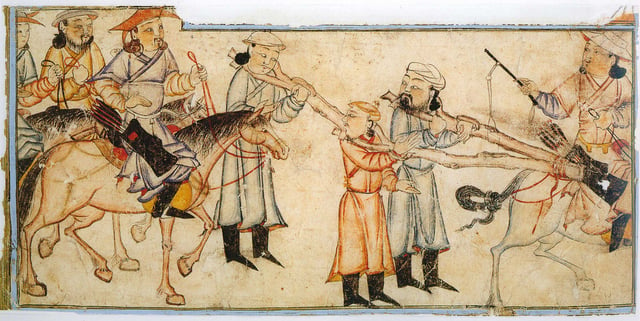
Mongol riders with prisoners, 14th century
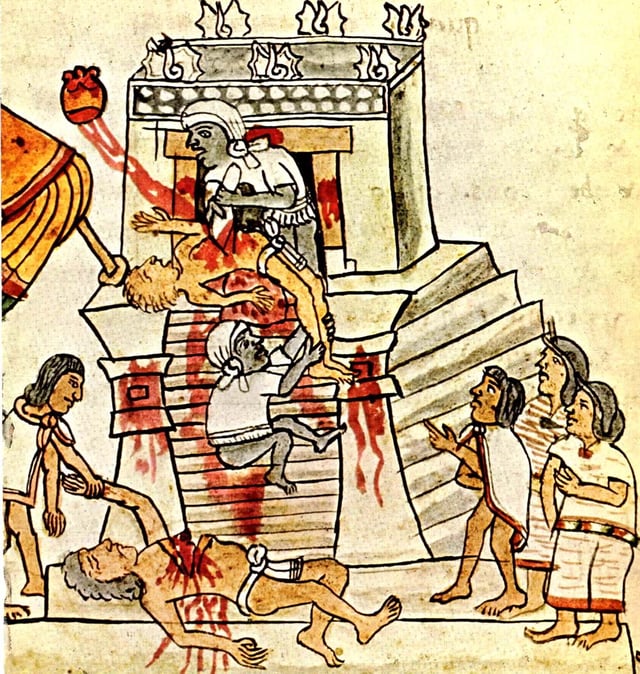
Aztec sacrifices, Codex Mendoza
During Childeric's siege and blockade of Paris in 464, the nun Geneviève (later canonised as the city's patron saint) pleaded with the Frankish king for the welfare of prisoners of war and met with a favourable response. Later, Clovis I liberated captives after Genevieve urged him to do so.[7]
Many French prisoners of war were killed during the Battle of Agincourt in 1415.[8] This was done in retaliation for the French killing of the boys and other non-combatants handling the baggage and equipment of the army, and because the French were attacking again and Henry was afraid that they would break through and free the prisoners to fight again.
In the later Middle Ages, a number of religious wars aimed to not only defeat but eliminate their enemies. In Christian Europe, the extermination of heretics was considered desirable. Examples include the 13th century Albigensian Crusade and the Northern Crusades.[9] When asked by a Crusader how to distinguish between the Catholics and Cathars once they'd taken the city of Béziers, the Papal Legate Arnaud Amalric famously replied, "Kill them all, God will know His own".[10]
Likewise, the inhabitants of conquered cities were frequently massacred during the Crusades against the Muslims in the 11th and 12th centuries. Noblemen could hope to be ransomed; their families would have to send to their captors large sums of wealth commensurate with the social status of the captive.
In feudal Japan, there was no custom of ransoming prisoners of war, who were for the most part summarily executed.[11]
The expanding Mongol Empire was famous for distinguishing between cities or towns that surrendered, where the population were spared but required to support the conquering Mongol army, and those that resisted, where their city was ransacked and destroyed, and all the population killed. In Termez, on the Oxus: "all the people, both men and women, were driven out onto the plain, and divided in accordance with their usual custom, then they were all slain".[12]
During the early Muslim conquests, Muslims routinely captured large number of prisoners. Aside from those who converted, most were ransomed or enslaved.[16][17] Christians who were captured during the Crusades were usually either killed or sold into slavery if they could not pay a ransom.[18] During his lifetime, Muhammad made it the responsibility of the Islamic government to provide food and clothing, on a reasonable basis, to captives, regardless of their religion; however if the prisoners were in the custody of a person, then the responsibility was on the individual.[19] The freeing of prisoners was highly recommended as a charitable act. On certain occasions where Muhammad felt the enemy had broken a treaty with the Muslims, he ordered the mass execution of male prisoners, such as the Banu Qurayza. Females and children of this tribe were divided up as ghanima (spoils of war) by Muhammad.[20]
Modern times
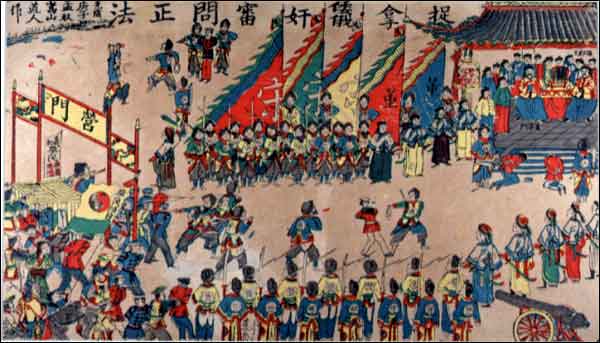
Russian and Japanese prisoners being interrogated by Chinese officials during the Boxer Rebellion.

Union Army soldier on his release from Andersonville prison in May 1865.
The 1648 Peace of Westphalia, which ended the Thirty Years' War, established the rule that prisoners of war should be released without ransom at the end of hostilities and that they should be allowed to return to their homelands.[21]
There also evolved the right of parole, French for "discourse", in which a captured officer surrendered his sword and gave his word as a gentleman in exchange for privileges. If he swore not to escape, he could gain better accommodations and the freedom of the prison. If he swore to cease hostilities against the nation who held him captive, he could be repatriated or exchanged but could not serve against his former captors in a military capacity.
European settlers captured in North America
Early historical narratives of captured colonial Europeans, including perspectives of literate women captured by the indigenous peoples of North America, exist in some number. The writings of Mary Rowlandson, captured in the brutal fighting of King Philip's War, are an example. Such narratives enjoyed some popularity, spawning a genre of the captivity narrative, and had lasting influence on the body of early American literature, most notably through the legacy of James Fenimore Cooper's The Last of the Mohicans. Some Native Americans continued to capture Europeans and use them both as labourers and bargaining chips into the 19th century; see for example John R. Jewitt, an Englishman who wrote a memoir about his years as a captive of the Nootka people on the Pacific Northwest coast from 1802 to 1805.
French Revolutionary wars and Napoleonic wars
The earliest known purposely built prisoner-of-war camp was established at Norman Cross, England in 1797 to house the increasing number of prisoners from the French Revolutionary Wars and the Napoleonic Wars. The average prison population was about 5,500 men. The lowest number recorded was 3,300 in October 1804 and 6,272 on 10 April 1810 was the highest number of prisoners recorded in any official document. Norman Cross was intended to be a model depot providing the most humane treatment of prisoners of war. The British government went to great lengths to provide food of a quality at least equal to that available to locals. The senior officer from each quadrangle was permitted to inspect the food as it was delivered to the prison to ensure it was of sufficient quality. Despite the generous supply and quality of food, some prisoners died of starvation after gambling away their rations. Most of the men held in the prison were low-ranking soldiers and sailors, including midshipmen and junior officers, with a small number of privateers. About 100 senior officers and some civilians "of good social standing", mainly passengers on captured ships and the wives of some officers, were given parole d'honneur outside the prison, mainly in Peterborough although some further afield in Northampton, Plymouth, Melrose and Abergavenny. They were afforded the courtesy of their rank within English society. During the Battle of Leipzig both sides used the city's cemetery as lazaret and prisoner camp for around 6000 POWs who lived in the vaults and used the coffins for firewood. Food was scarce and prisoners resorted to eating horses, cats, dogs or even human flesh. The bad conditions inside the graveyard contributed to a city-wide epidemic after the battle.[22][23]
Prisoner exchanges
The extensive period of conflict during the American Revolutionary War and Napoleonic Wars (1793–1815), followed by the Anglo-American War of 1812, led to the emergence of a cartel system for the exchange of prisoners, even while the belligerents were at war. A cartel was usually arranged by the respective armed service for the exchange of like-ranked personnel. The aim was to achieve a reduction in the number of prisoners held, while at the same time alleviating shortages of skilled personnel in the home country.
American Civil War

Union prisoners of war on the way to Camp Ford prison in October 1864.
At the start of the civil war a system of paroles operated. Captives agreed not to fight until they were officially exchanged. Meanwhile, they were held in camps run by their own army where they were paid but not allowed to perform any military duties.[24] The system of exchanges collapsed in 1863 when the Confederacy refused to exchange black prisoners. In the late summer of 1864, a year after the Dix–Hill Cartel was suspended; Confederate officials approached Union General Benjamin Butler, Union Commissioner of Exchange, about resuming the cartel and including the black prisoners. Butler contacted Grant for guidance on the issue, and Grant responded to Butler on 18 August 1864 with his now famous statement. He rejected the offer, stating in essence, that the Union could afford to leave their men in captivity, the Confederacy could not.[25] After that about 56,000 of the 409,000 POWs died in prisons during the American Civil War, accounting for nearly 10% of the conflict's fatalities.[26] Of the 45,000 Union prisoners of war confined in Camp Sumter, located near Andersonville, Georgia, 13,000 (28%) died.[27] At Camp Douglas in Chicago, Illinois, 10% of its Confederate prisoners died during one cold winter month; and Elmira Prison in New York state, with a death rate of 25% (2,963), nearly equalled that of Andersonville.[28]
Amelioration
During the 19th century, there were increased efforts to improve the treatment and processing of prisoners. As a result of these emerging conventions, a number of international conferences were held, starting with the Brussels Conference of 1874, with nations agreeing that it was necessary to prevent inhumane treatment of prisoners and the use of weapons causing unnecessary harm. Although no agreements were immediately ratified by the participating nations, work was continued that resulted in new conventions being adopted and becoming recognized as international law that specified that prisoners of war be treated humanely and diplomatically.
Hague and Geneva Conventions
Chapter II of the Annex to the 1907 Hague Convention IV – The Laws and Customs of War on Land covered the treatment of prisoners of war in detail. These provisions were further expanded in the 1929 Geneva Convention on the Prisoners of War and were largely revised in the Third Geneva Convention in 1949.
Article 4 of the Third Geneva Convention protects captured military personnel, some guerrilla fighters, and certain civilians. It applies from the moment a prisoner is captured until he or she is released or repatriated. One of the main provisions of the convention makes it illegal to torture prisoners and states that a prisoner can only be required to give their name, date of birth, rank and service number (if applicable).
The ICRC has a special role to play, with regards to international humanitarian law, in restoring and maintaining family contact in times of war, in particular concerning the right of prisoners of war and internees to send and receive letters and cards (Geneva Convention (GC) III, art.71 and GC IV, art.107).
However, nations vary in their dedication to following these laws, and historically the treatment of POWs has varied greatly. During World War II, Imperial Japan and Nazi Germany (towards Soviet POWs and Western Allied commandos) were notorious for atrocities against prisoners of war. The German military used the Soviet Union's refusal to sign the Geneva Convention as a reason for not providing the necessities of life to Soviet POWs; and the Soviets similarly killed Axis prisoners or used them as slave labour. The Germans also routinely executed Western Allied commandos captured behind German lines per the Commando Order. North Korean and North and South Vietnamese forces[29] routinely killed or mistreated prisoners taken during those conflicts.
Qualifications

Japanese illustration depicting the beheading of Chinese captives. Sino-Japanese War of 1894–5.
To be entitled to prisoner-of-war status, captured persons must be lawful combatants entitled to combatant's privilege—which gives them immunity from punishment for crimes constituting lawful acts of war such as killing enemy combatants. To qualify under the Third Geneva Convention, a combatant must be part of a chain of command, wear a "fixed distinctive marking, visible from a distance", bear arms openly, and have conducted military operations according to the laws and customs of war. (The Convention recognizes a few other groups as well, such as "[i]nhabitants of a non-occupied territory, who on the approach of the enemy spontaneously take up arms to resist the invading forces, without having had time to form themselves into regular armed units".)
Thus, uniforms and badges are important in determining prisoner-of-war status; and francs-tireurs, militias, insurgents, terrorists, saboteurs, mercenaries, and spies generally do not qualify because they do not always follow the laws and customs of war, and often don't wear any insignia. Therefore they fall under the category of unlawful combatants. In practice, these criteria are rarely interpreted strictly. Guerrillas, for example, usually do not wear a uniform or carry arms openly, but captured guerrillas are often granted POW status.
The criteria are applied primarily to international armed conflicts; in civil wars, insurgents are often treated as traitors, terrorists or criminals by government forces and are sometimes executed on spot or tortured. However, in the American Civil War, both sides treated captured troops as POWs presumably out of reciprocity, although the Union regarded Confederate personnel as separatist rebels. However, guerrillas and other irregular combatants generally cannot expect to receive benefits from both civilian and military status simultaneously.
Rights
Under the Third Geneva Convention, prisoners of war (POW) must be:
Treated humanely with respect for their persons and their honor
Able to inform their next of kin and the International Committee of the Red Cross of their capture
Allowed to communicate regularly with relatives and receive packages
Given adequate food, clothing, housing, and medical attention
Paid for work done and not forced to do work that is dangerous, unhealthy, or degrading
Released quickly after conflicts end
Not compelled to give any information except for name, age, rank, and service number[30]
In addition, if wounded or sick on the battlefield, the prisoner will receive help from the International Committee of the Red Cross.[31]
When a country is responsible for breaches of prisoner of war rights, those accountable will be punished accordingly. An example of this is the Nuremberg and Tokyo Trials. German and Japanese military commanders were prosecuted for preparing and initiating a war of aggression, murder, ill treatment, and deportation of individuals, and genocide during World War II.[32] Most were executed or sentenced to life in prison for their crimes.
U.S. Code of Conduct and terminology
The United States Military Code of Conduct was promulgated in 1955 via Executive Order 10631 under President Dwight D. Eisenhower to serve as a moral code for United States service members who have been taken prisoner. It was created primarily in response to the breakdown of leadership and organization, specifically when U.S. forces were POWs during the Korean War.
When a military member is taken prisoner, the Code of Conduct reminds them that the chain of command is still in effect (the highest ranking service member eligible for command, regardless of service branch, is in command), and requires them to support their leadership. The Code of Conduct also requires service members to resist giving information to the enemy (beyond identifying themselves, that is, "name, rank, serial number"), receiving special favors or parole, or otherwise providing their enemy captors aid and comfort.
Since the Vietnam War, the official U.S. military term for enemy POWs is EPW (Enemy Prisoner of War). This name change was introduced in order to distinguish between enemy and U.S. captives.[33][34]
In 2000, the U.S. military replaced the designation "Prisoner of War" for captured American personnel with "Missing-Captured". A January 2008 directive states that the reasoning behind this is since "Prisoner of War" is the international legal recognized status for such people there is no need for any individual country to follow suit. This change remains relatively unknown even among experts in the field and "Prisoner of War" remains widely used in the Pentagon which has a "POW/Missing Personnel Office" and awards the Prisoner of War Medal.[35][36]
World War I
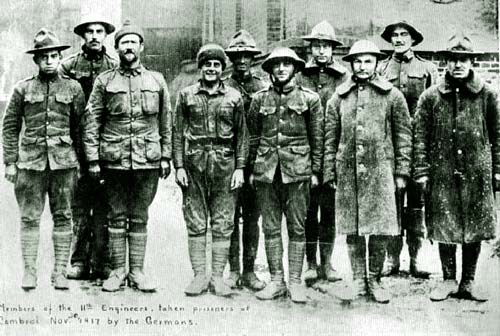
American prisoners of war in Germany in 1917
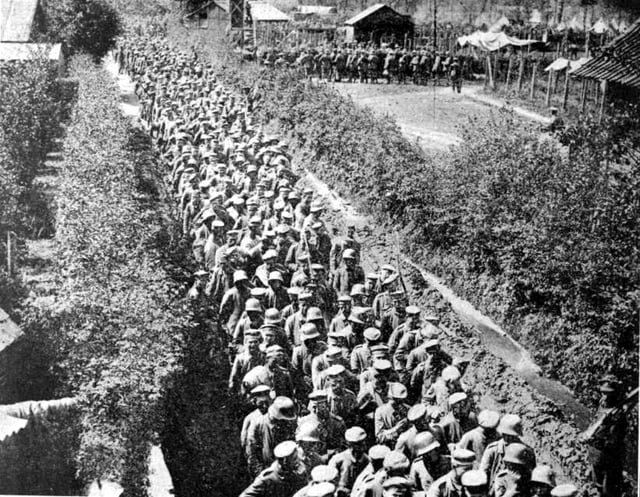
German soldiers captured by the British in Flanders.
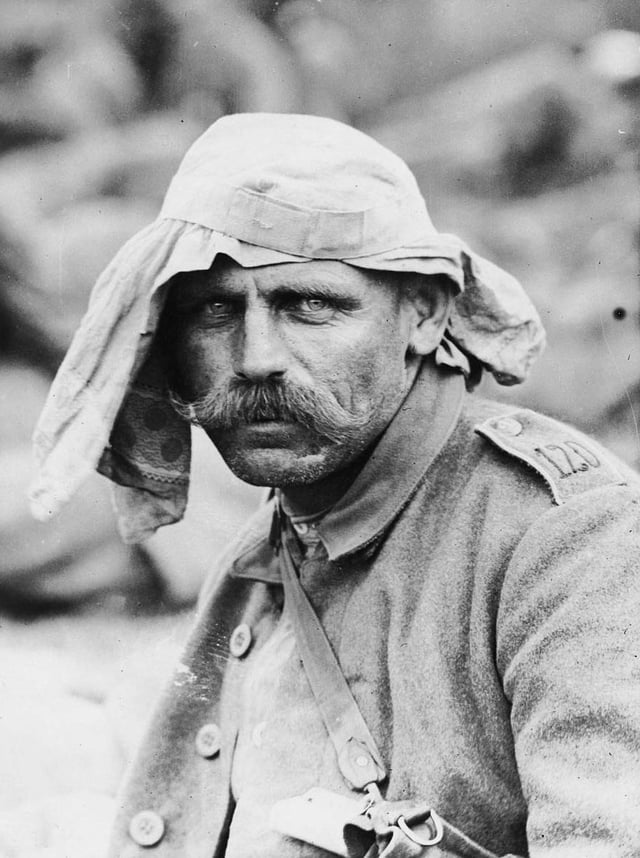
German soldier of 120th Infantry Regiment POW 1 January 1918
During World War I, about eight million men surrendered and were held in POW camps until the war ended. All nations pledged to follow the Hague rules on fair treatment of prisoners of war, and in general the POWs had a much higher survival rate than their peers who were not captured.[37] Individual surrenders were uncommon; usually a large unit surrendered all its men. At Tannenberg 92,000 Russians surrendered during the battle. When the besieged garrison of Kaunas surrendered in 1915, 20,000 Russians became prisoners. Over half the Russian losses were prisoners as a proportion of those captured, wounded or killed. About 3.3 million men became prisoners.[38]
The German Empire held 2.5 million prisoners; Russia held 2.9 million, and Britain and France held about 720,000, mostly gained in the period just before the Armistice in 1918. The US held 48,000. The most dangerous moment for POWs was the act of surrender, when helpless soldiers were sometimes mistakenly shot down. Once prisoners reached a POW camp conditions were better (and often much better than in World War II), thanks in part to the efforts of the International Red Cross and inspections by neutral nations.
There was however much harsh treatment of POWs in Germany, as recorded by the American ambassador to Germany (prior to America's entry into the war), James W. Gerard, who published his findings in "My Four Years in Germany". Even worse conditions are reported in the book "Escape of a Princess Pat" by the Canadian George Pearson. It was particularly bad in Russia, where starvation was common for prisoners and civilians alike; a quarter of the over 2 million POWs held there died.[39] Nearly 375,000 of the 500,000 Austro-Hungarian prisoners of war taken by Russians perished in Siberia from smallpox and typhus.[40] In Germany, food was short, but only 5% died.[41]
The Ottoman Empire often treated prisoners of war poorly. Some 11,800 British soldiers, most of them Indians, became prisoners after the five-month Siege of Kut, in Mesopotamia, in April 1916. Many were weak and starved when they surrendered and 4,250 died in captivity.[42]
During the Sinai and Palestine campaign 217 Australian and unknown numbers of British, New Zealand and Indian soldiers were captured by Ottoman Empire forces. About 50% of the Australian prisoners were light horsemen including 48 missing believed captured on 1 May 1918 in the Jordan Valley. Australian Flying Corps pilots and observers were captured in the Sinai Peninsula, Palestine and the Levant. One third of all Australian prisoners were captured on Gallipoli including the crew of the submarine AE2 which made a passage through the Dardanelles in 1915. Forced marches and crowded railway journeys preceded years in camps where disease, poor diet and inadequate medical facilities prevailed. About 25% of other ranks died, many from malnutrition, while only one officer died.[43][44]
The most curious case came in Russia where the Czechoslovak Legion of Czechoslovak prisoners (from the Austro-Hungarian army): they were released in 1917, armed themselves, briefly culminating into a military and diplomatic force during the Russian Civil War.
Release of prisoners

A memorial to German prisoners of war who died in 1914–1920
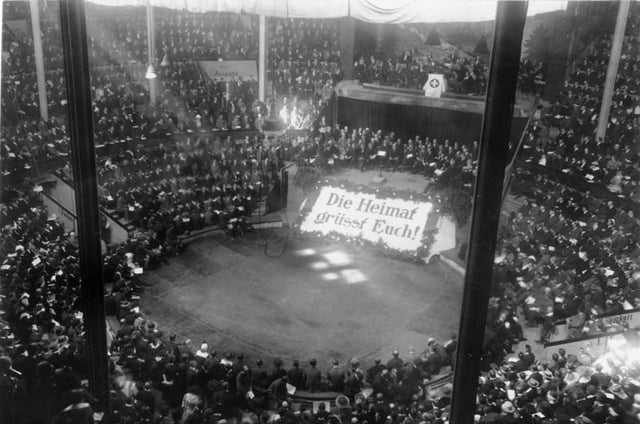
Celebration for returning POWs, Berlin 1920
At the end of the war in 1918 there were believed to be 140,000 British prisoners of war in Germany, including thousands of internees held in neutral Switzerland.[45] The first British prisoners were released and reached Calais on 15 November. Plans were made for them to be sent via Dunkirk to Dover and a large reception camp was established at Dover capable of housing 40,000 men, which could later be used for demobilisation.
On 13 December 1918, the armistice was extended and the Allies reported that by 9 December 264,000 prisoners had been repatriated. A very large number of these had been released en masse and sent across Allied lines without any food or shelter. This created difficulties for the receiving Allies and many released prisoners died from exhaustion. The released POWs were met by cavalry troops and sent back through the lines in lorries to reception centres where they were refitted with boots and clothing and dispatched to the ports in trains.
Upon arrival at the receiving camp the POWs were registered and "boarded" before being dispatched to their own homes. All commissioned officers had to write a report on the circumstances of their capture and to ensure that they had done all they could to avoid capture. Each returning officer and man was given a message from King George V, written in his own hand and reproduced on a lithograph. It read as follows:[46]
The Queen joins me in welcoming you on your release from the miseries & hardships, which you have endured with so much patience and courage. During these many months of trial, the early rescue of our gallant Officers & Men from the cruelties of their captivity has been uppermost in our thoughts. We are thankful that this longed for day has arrived, & that back in the old Country you will be able once more to enjoy the happiness of a home & to see good days among those who anxiously look for your return. George R.I.
While the Allied prisoners were sent home at the end of the war, the same treatment was not granted to Central Powers prisoners of the Allies and Russia, many of whom had to serve as forced labour, e.g. in France, until 1920. They were released after many approaches by the ICRC to the Allied Supreme Council.[47]
World War II
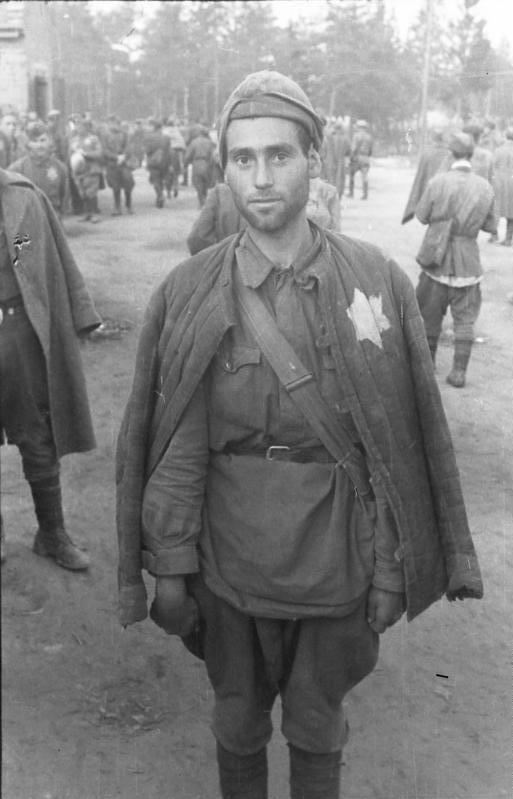
Jewish Soviet POW captured by the German Army, August 1941. At least 50,000 Jewish soldiers were executed after selection.
| Percentage of POWs that Died | |
|---|---|
| Soviet POWs held by Germans | 57.5% |
| German POWs held by Yugoslavs | 41.2% |
| German POWs held by Soviets | 35.8% |
| American POWs held by Japanese | 33.0% |
| American POWs held by Germans | 1.19% |
| German POWs held by Eastern Europeans | 32.9% |
| British POWs held by Japanese | 24.8% |
| German POWs held by Czechoslovaks | 5.0% |
| British POWs held by Germans | 3.5% |
| German POWs held by French | 2.58% |
| German POWs held by Americans | 0.15% |
| German POWs held by British | 0.03% |
Treatment of POWs by the Axis
Empire of Japan
The Empire of Japan, which had signed but never ratified the 1929 Geneva Convention on Prisoners of War,[50] did not treat prisoners of war in accordance with international agreements, including provisions of the Hague Conventions, either during the Second Sino-Japanese War or during the Pacific War, because the Japanese viewed surrender as dishonorable. Moreover, according to a directive ratified on 5 August 1937 by Hirohito, the constraints of the Hague Conventions were explicitly removed on Chinese prisoners.[51]
Prisoners of war from China, the United States, Australia, Britain, Canada, India, the Netherlands, New Zealand, and the Philippines held by the Japanese armed forces were subject to murder, beatings, summary punishment, brutal treatment, forced labour, medical experimentation, starvation rations, poor medical treatment and cannibalism.[52] The most notorious use of forced labour was in the construction of the Burma–Thailand Death Railway. After 20 March 1943, the Imperial Navy was under orders to execute all prisoners taken at sea.[53]
According to the findings of the Tokyo Tribunal, the death rate of Western prisoners was 27.1%, seven times that of POWs under the Germans and Italians.[54] The death rate of Chinese was much higher. Thus, while 37,583 prisoners from the United Kingdom, Commonwealth, and Dominions, 28,500 from the Netherlands, and 14,473 from the United States were released after the surrender of Japan, the number for the Chinese was only 56.[55] The 27,465 United States Army and United States Army Air Forces POWs in the Pacific Theater had a 40.4% death rate.[56] The War Ministry in Tokyo issued an order at the end of the war to kill all surviving POWs.[57]
No direct access to the POWs was provided to the International Red Cross. Escapes among Caucasian prisoners were almost impossible because of the difficulty of men of Caucasian descent hiding in Asiatic societies.[58]
Allied POW camps and ship-transports were sometimes accidental targets of Allied attacks. The number of deaths which occurred when Japanese "hell ships"—unmarked transport ships in which POWs were transported in harsh conditions—were attacked by US Navy submarines was particularly high. Gavan Daws has calculated that "of all POWs who died in the Pacific War, one in three was killed on the water by friendly fire".[59] Daves states that 10,800 of the 50,000 POWs shipped by the Japanese were killed at sea[60] while Donald L. Miller states that "approximately 21,000 Allied POWs died at sea, about 19,000 of them killed by friendly fire."[61]
Life in the POW camps was recorded at great risk to themselves by artists such as Jack Bridger Chalker, Philip Meninsky, Ashley George Old, and Ronald Searle. Female prisoners (detainees) at Changi prisoner of war camp in Singapore, bravely recorded their defiance in seemingly harmless prison quilt embroidery[62]. For the artists, human hair was often used for brushes, plant juices and blood for paint, and toilet paper as the "canvas". Some of their works were used as evidence in the trials of Japanese war criminals.
Research into the conditions of the camps has been conducted by The Liverpool School of Tropical Medicine.[63]
Germany
French soldiers
After the French armies surrendered in summer 1940, Germany seized two million French prisoners of war and sent them to camps in Germany. About one third were released on various terms. Of the remainder, the officers and non-commissioned officers were kept in camps and did not work. The privates were sent out to work. About half of them worked for German agriculture, where food supplies were adequate and controls were lenient. The others worked in factories or mines, where conditions were much harsher.[64]
Western Allies' POWs
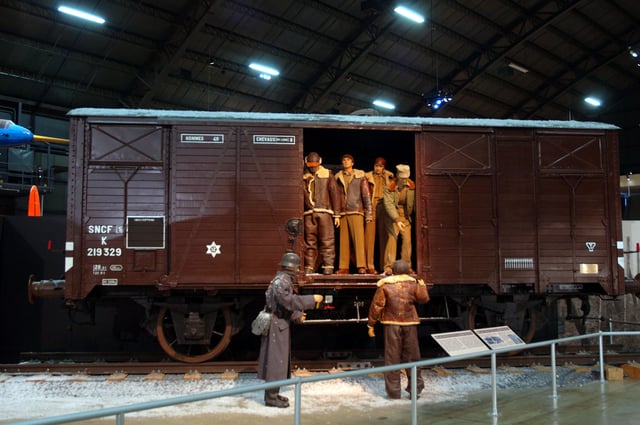
Representation of a "Forty-and-eight" boxcar used to transport American POWs in Germany during World War II.
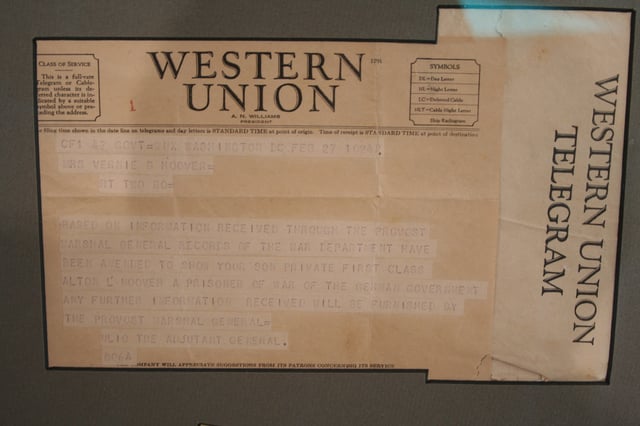
Telegram notifying parents of an American POW of his capture by Germany
Germany and Italy generally treated prisoners from the British Commonwealth, France, the US, and other western Allies in accordance with the Geneva Convention, which had been signed by these countries.[65] Consequently, western Allied officers were not usually made to work and some personnel of lower rank were usually compensated, or not required to work either. The main complaints of western Allied prisoners of war in German POW camps—especially during the last two years of the war—concerned shortages of food.
Only a small proportion of western Allied POWs who were Jews—or whom the Nazis believed to be Jewish—were killed as part of the Holocaust or were subjected to other antisemitic policies. For example, Major Yitzhak Ben-Aharon, a Palestinian Jew who had enlisted in the British Army, and who was captured by the Germans in Greece in 1941, experienced four years of captivity under entirely normal conditions for POWs.[66]
However, a small number of Allied personnel were sent to concentration camps, for a variety of reasons including being Jewish.[67] As the US historian Joseph Robert White put it: "An important exception ... is the sub-camp for U.S. POWs at Berga an der Elster, officially called Arbeitskommando 625 [also known as Stalag IX-B]. Berga was the deadliest work detachment for American captives in Germany. 73 men who participated, or 21 percent of the detachment, perished in two months. 80 of the 350 POWs were Jews." Another well-known example was a group of 168 Australian, British, Canadian, New Zealand and US aviators who were held for two months at Buchenwald concentration camp;[68] two of the POWs died at Buchenwald. Two possible reasons have been suggested for this incident: German authorities wanted to make an example of Terrorflieger ("terrorist aviators") or these aircrews were classified as spies, because they had been disguised as civilians or enemy soldiers when they were apprehended.
Information on conditions in the stalags is contradictory depending on the source. Some American POWs claimed the Germans were victims of circumstance and did the best they could, while others accused their captors of brutalities and forced labour. In any case, the prison camps were miserable places where food rations were meager and conditions squalid. One American admitted "The only difference between the stalags and concentration camps was that we weren't gassed or shot in the former. I do not recall a single act of compassion or mercy on the part of the Germans." Typical meals consisted of a bread slice and watery potato soup which, however, was still more substantial than what Soviet POWs or concentration camp inmates received. Another prisoner stated that "The German plan was to keep us alive, yet weakened enough that we wouldn't attempt escape."[69]
As Soviet ground forces approached some POW camps in early 1945, German guards forced western Allied POWs to walk long distances towards central Germany, often in extreme winter weather conditions. It is estimated that, out of 257,000 POWs, about 80,000 were subject to such marches and up to 3,500 of them died as a result.
Italian POWs
In September 1943 after the Armistice, Italian officers and soldiers that in many places waited for clear superior orders, were arrested by Germans and Italian fascists and taken to German internment camps in Germany or Eastern Europe, where they were held for the duration of World War II. The International Red Cross could do nothing for them, as they were not regarded as POWs, but the prisoners held the status of "military internees". Treatment of the prisoners was generally poor. The author Giovannino Guareschi was among those interned and wrote about this time in his life. The book was translated and published as "My Secret Diary". He wrote about the hungers of semi-starvation, the casual murder of individual prisoners by guards and how, when they were released (now from a German camp), they found a deserted German town filled with foodstuffs that they (with other released prisoners) ate.. It is estimated that of the 700,000 Italians taken prisoner by the Germans, around 40,000 died in detention and more than 13,000 lost their lives during the transportation from the Greek islands to the mainland.[70]
Eastern European POWs
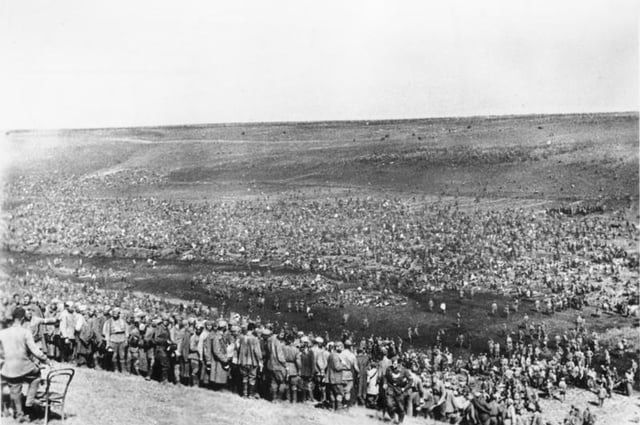
An improvised camp for Soviet POWs. Between June 1941 and January 1942, the Nazis killed an estimated 2.8 million Soviet prisoners of war, whom they viewed as "subhuman".[71]
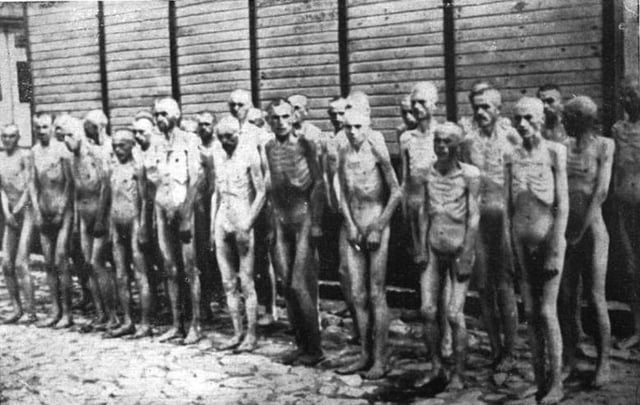
Naked Soviet prisoners of war in Mauthausen concentration camp.
Germany did not apply the same standard of treatment to non-western prisoners, especially many Polish and Soviet POWs who suffered harsh conditions and died in large numbers while in captivity.
Between 1941 and 1945 the Axis powers took about 5.7 million Soviet prisoners. About one million of them were released during the war, in that their status changed but they remained under German authority. A little over 500,000 either escaped or were liberated by the Red Army. Some 930,000 more were found alive in camps after the war. The remaining 3.3 million prisoners (57.5% of the total captured) died during their captivity.[72] Between the launching of Operation Barbarossa in the summer of 1941 and the following spring, 2.8 million of the 3.2 million Soviet prisoners taken died while in German hands.[73] According to Russian military historian General Grigoriy Krivosheyev, the Axis powers took 4.6 million Soviet prisoners, of whom 1.8 million were found alive in camps after the war and 318,770 were released by the Axis during the war and were then drafted into the Soviet armed forces again.[74] By comparison, 8,348 Western Allied prisoners died in German camps during 1939–45 (3.5% of the 232,000 total).[75]
The Germans officially justified their policy on the grounds that the Soviet Union had not signed the Geneva Convention. Legally, however, under article 82 of the Geneva Convention, signatory countries had to give POWs of all signatory and non-signatory countries the rights assigned by the convention. [76] Shortly after the German invasion in 1941, the USSR made Berlin an offer of a reciprocal adherence to the Hague Conventions. Third Reich officials left the Soviet "note" unanswered.[77][78] In contrast, Nikolai Tolstoy recounts that the German Government – as well as the International Red Cross – made several efforts to regulate reciprocal treatment of prisoners until early 1942, but received no answers from the Soviet side.[79] Further, the Soviets took a harsh position towards captured Soviet soldiers, as they expected each soldier to fight to the death, and automatically excluded any prisoner from the "Russian community".[80]
Some Soviet POWs and forced labourers whom the Germans had transported to Nazi Germany were, on their return to the USSR, treated as traitors and sent to gulag prison-camps.
Treatment of POWs by the Soviet Union
Germans, Romanians, Italians, Hungarians, Finns
According to some sources, the Soviets captured 3.5 million Axis servicemen (excluding Japanese) of which more than a million died.[81] One specific example is that of the German POWs after the Battle of Stalingrad, where the Soviets captured 91,000 German troops in total (completely exhausted, starving and sick) of whom only 5,000 survived the captivity.
German soldiers were kept as forced labour for many years after the war. The last German POWs like Erich Hartmann, the highest-scoring fighter ace in the history of aerial warfare, who had been declared guilty of war crimes but without due process, were not released by the Soviets until 1955, three years after Stalin died.[82]
Polish

Katyn 1943 exhumation. Photo by International Red Cross delegation.
As a result of the Soviet invasion of Poland in 1939, hundreds of thousands of Polish soldiers became prisoners of war in the Soviet Union. Thousands of them were executed; over 20,000 Polish military personnel and civilians perished in the Katyn massacre.[83] Out of Anders' 80,000 evacuees from Soviet Union gathered in the United Kingdom only 310 volunteered to return to Poland in 1947.[84]
Out of the 230,000 Polish prisoners of war taken by the Soviet army, only 82,000 survived.[85]
Japanese
With the Soviet invasion of Manchuria, in 1945, Japanese soldiers became prisoners in the Soviet Union, where they, just as other Axis POWs, had to work.
Americans
There were stories during the Cold War to the effect that 23,000 Americans who had been held in German POW camps were seized by the Soviets and never repatriated. This myth had been perpetuated after the release of people like John H. Noble. Careful scholarly studies have demonstrated this is a myth based on a misinterpretation of a telegram that was talking about Soviet prisoners held in Italy.[86]
Treatment of POWs by the Western Allies
Germans

Remagen open-field Rheinwiesenlager
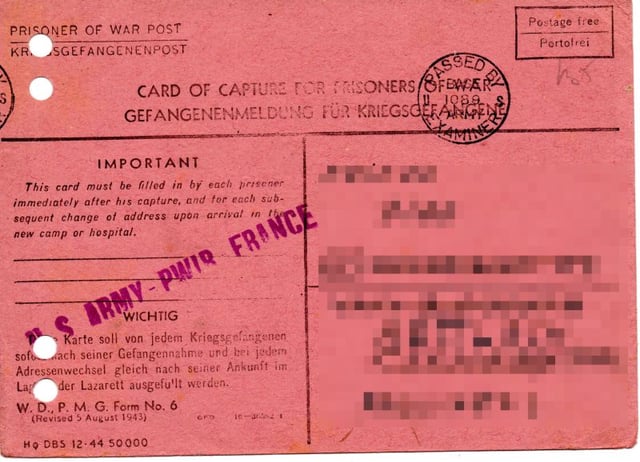
US Army: Card of capture for German POWs – front
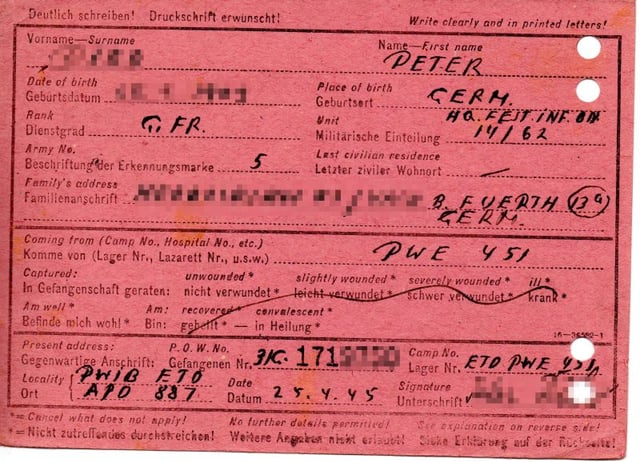
The reverse of above card

Certificate of Dischargeof a German General(Front- and Backside)
During the war, the armies of Western Allied nations such as Australia, Canada, the UK and the US[87] were ordered to treat Axis prisoners strictly in accordance with the Geneva Convention.[88] Some breaches of the Convention took place, however. According to Stephen E. Ambrose, of the roughly 1,000 US combat veterans that he had interviewed, only one admitted to shooting a prisoner, saying that he "felt remorse, but would do it again". However, one-third told him they had seen US troops kill German prisoners.[89]
Towards the end of the war in Europe, as large numbers of Axis soldiers surrendered, the US created the designation of Disarmed Enemy Forces (DEF) so as not to treat prisoners as POWs. A lot of these soldiers were kept in open fields in makeshift camps in the Rhine valley (Rheinwiesenlager). Controversy has arisen about how Eisenhower managed these prisoners[90] (see Other Losses).
After the surrender of Germany in May 1945, the POW status of the German prisoners was in many cases maintained, and they were for several years used as forced labour in countries such as the UK and France. Many died when forced to clear minefields in Norway, France etc.; "by September 1945 it was estimated by the French authorities that two thousand prisoners were being maimed and killed each month in accidents"[91][92]
In 1946, the UK had more than 400,000 German prisoners, many had been transferred from POW camps in the US and Canada. Many of these were for over three years after the German surrender used as forced labour, as a form of "reparations".[93][94] A public debate ensued in the UK, where words such as "forced labour", "slaves", "slave labour" were increasingly used in the media and in the House of Commons.[95] In 1947 the Ministry of Agriculture argued against repatriation of working German prisoners, since by then they made up 25 percent of the land workforce, and they wanted to use them also in 1948.[95]
The "London Cage", an MI19 prisoner of war facility in the UK used for interrogating prisoners before they were sent to prison camps during and immediately after World War II, was subject to allegations of torture.[96]
After the German surrender, the International Red Cross was prohibited from providing aid such as food or visiting prisoner camps in Germany. However, after making approaches to the Allies in the autumn of 1945 it was allowed to investigate the camps in the British and French occupation zones of Germany, as well as to provide relief to the prisoners held there.[97] On 4 February 1946, the Red Cross was permitted to visit and assist prisoners also in the US occupation zone of Germany, although only with very small quantities of food. "During their visits, the delegates observed that German prisoners of war were often detained in appalling conditions. They drew the attention of the authorities to this fact, and gradually succeeded in getting some improvements made".[97]
The Allies also shipped POWs between them, with for example 6,000 German officers transferred from Western Allied camps to the Sachsenhausen concentration camp that now was under Soviet Union administration.[98] The US also shipped 740,000 German POWs as forced labourers to France from where newspaper reports told of very bad treatment. Judge Robert H. Jackson, Chief US prosecutor in the Nuremberg trials, in October 1945 told US President Harry S. Truman that the Allies themselves:
Hungarians
Hungarians became POWs of the Western Allies. Some of these were, like Germans, used as forced labour in France after the cessation of hostilities.[101] After the war the POWs were handed over to the Soviets, and after the POWs were transported to the USSR for forced labour. It is called even today in Hungary malenkij robot—little work. András Toma, a Hungarian soldier taken prisoner by the Red Army in 1944, was discovered in a Russian psychiatric hospital in 2000. He was probably the last prisoner of war from World War II to be repatriated.[102]
Japanese
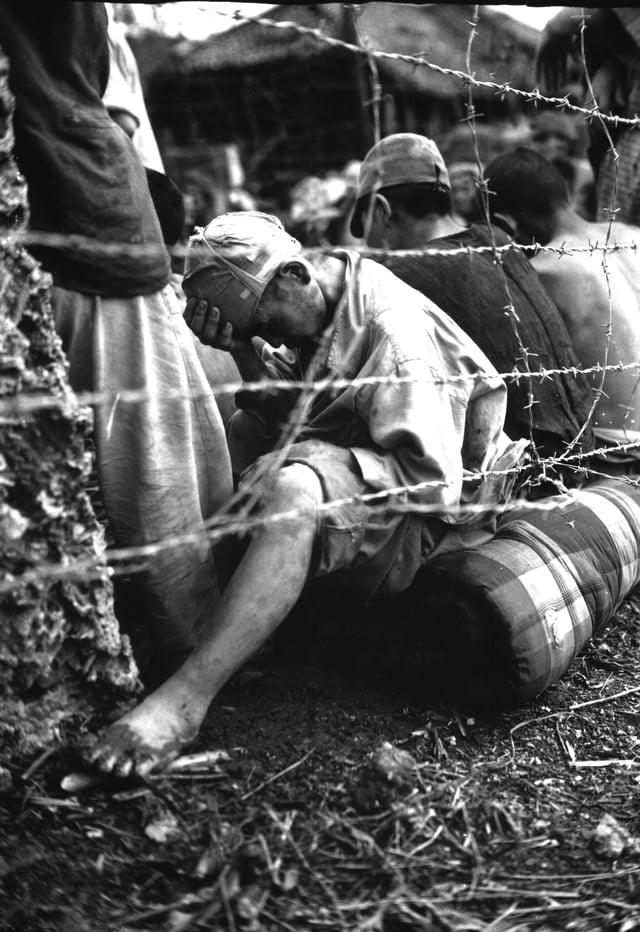
A group of Japanese captured during the Battle of Okinawa
Although thousands of Japanese were taken prisoner, most fought until they were killed or committed suicide. Of the 22,000 Japanese soldiers present at the beginning of the Battle of Iwo Jima, over 20,000 were killed and only 216 were taken prisoner.[103] Of the 30,000 Japanese troops that defended Saipan, fewer than 1,000 remained alive at battle's end.[104] Japanese prisoners sent to camps fared well; however, some Japanese were killed when trying to surrender or were massacred[105] just after they had surrendered (see Allied war crimes during World War II in the Pacific). In some instances, Japanese prisoners were tortured by a variety of methods.[106] A method of torture used by the Chinese National Revolutionary Army (NRA) included suspending the prisoner by the neck in a wooden cage until they died.[106][107] In very rare cases, some were beheaded by sword, and a severed head was once used as a football by Chinese National Revolutionary Army (NRA) soldiers.[106][108]
After the war, many Japanese were kept on as Japanese Surrendered Personnel until mid-1947 and used as forced labour doing menial tasks, while 35,000 were kept on in arms within their wartime military organisation and under their own officers and used in combat alongside British troops seeking to suppress the independence movements in the Dutch East Indies and French Indochina.
Italians
Cossacks
On 11 February 1945, at the conclusion of the Yalta Conference, the United States and the United Kingdom signed a Repatriation Agreement with the USSR.[110] The interpretation of this Agreement resulted in the forcible repatriation of all Soviets (Operation Keelhaul) regardless of their wishes. The forced repatriation operations took place in 1945–1947.[111]
Transfers between the Allies
The United States handed over 740,000 German prisoners to France, a signatory of the Geneva Convention. The Soviet Union had not signed the Geneva Convention. According to Edward Peterson, the U.S. chose to hand over several hundred thousand German prisoners to the Soviet Union in May 1945 as a "gesture of friendship".[112] U.S. forces also refused to accept the surrender of German troops attempting to surrender to them in Saxony and Bohemia, and handed them over to the Soviet Union instead.[113] It is also known that 6000 of the German officers who were sent from camps in the West to the Soviets were subsequently imprisoned in the Sachsenhausen concentration camp, which at the time was one of the NKVD special camp.[114][115]
Post-World War II
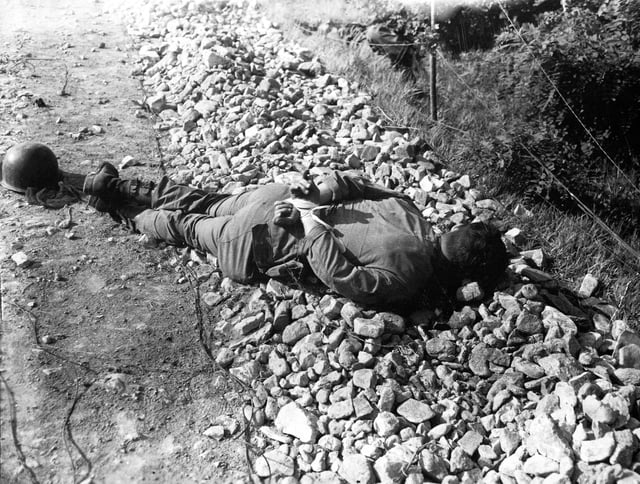
A U.S. Army POW of the 21st Infantry Regiment bound and killed by North Koreans during the Korean War.
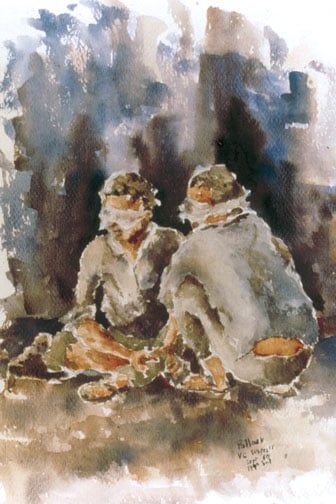
Waiting interrogation, 199th LT INF BG by James Pollock Vietnam War
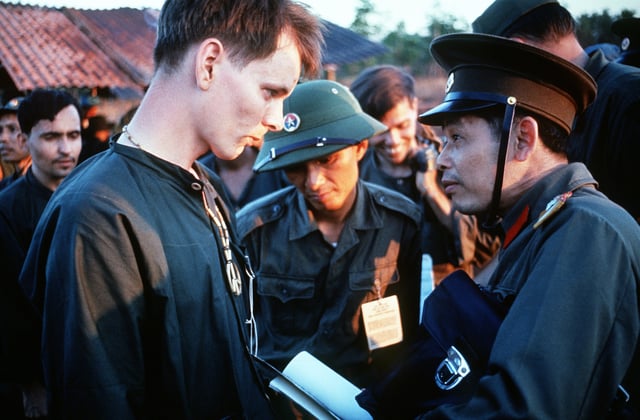
An American POW being released by his North Vietnamese and Viet Cong captors in February 1973.

Recently released American POWs from North Vietnamese prison camps in 1973.
During the Korean War, the North Koreans developed a reputation for severely mistreating prisoners of war (see Crimes against POWs). Their POWs were housed in three camps, according to their potential usefulness to the North Korean army. Peace camps and reform camps were for POWs that were either sympathetic to the cause or who had valued skills that could be useful in the army and thus these enemy soldiers were indoctrinated and sometimes conscripted into the North Korean army. The regular prisoners of war were usually very poorly treated. POWs in peace camps were reportedly treated with more consideration.[116]
In 1952, the 1952 Inter-Camp P.O.W. Olympics were held during 15 and 27 November 1952, in Pyuktong, North Korea. The Chinese hoped to gain worldwide publicity and while some prisoners refused to participate some 500 P.O.W.s of eleven nationalities took part.[117] They were representative of all the prison camps in North Korea and competed in: football, baseball, softball, basketball, volleyball, track and field, soccer, gymnastics, and boxing.[117] For the P.O.W.s this was also an opportunity to meet with friends from other camps. The prisoners had their own photographers, announcers, even reporters, who after each day's competition published a newspaper, the "Olympic Roundup".[118]
Of about 16,500 French soldiers who fought at the Battle of Dien Bien Phu in French Indochina, more than 3,000 were killed in battle, while almost all of the 11,721 men taken prisoner died in the hands of the Viet Minh on death marches to distant POW camps, and in those camps in the last three months of the war.[119]
The Vietcong and the North Vietnamese Army captured many United States service members as prisoners of war during the Vietnam War, who suffered from mistreatment and torture during the war. Some American prisoners were held in the prison called the Hanoi Hilton.
Communist Vietnamese held in custody by South Vietnamese and American forces were also tortured and badly treated.[29] After the war, millions of South Vietnamese servicemen and government workers were sent to "re-education" camps where many perished.
Regardless of regulations determining treatment to prisoners, violations of their rights continue to be reported. Many cases of POW massacres have been reported in recent times, including 13 October massacre in Lebanon by Syrian forces and June 1990 massacre in Sri Lanka.
In 1982, during the Falklands War, prisoners were well treated in general by both parties of the conflict, with military commanders dispatching 'enemy' prisoners back to their homelands in record time.[123]
In 1991, during the Persian Gulf War, American, British, Italian, and Kuwaiti POWs (mostly crew members of downed aircraft and special forces) were tortured by the Iraqi secret police. An American military doctor, Major Rhonda Cornum, a 37-year-old flight surgeon captured when her Blackhawk UH-60 was shot down, was also subjected to sexual abuse.[124]
During the 1990s Yugoslav Wars, Serb paramilitary forces supported by JNA forces killed POWs at Vukovar and Škarbrnja while Bosnian Serb forces killed POWs at Srebrenica.
In 2001, there were reports concerning two POWs that India had taken during the Sino-Indian War, Yang Chen and Shih Liang. The two were imprisoned as spies for three years before being interned in a mental asylum in Ranchi, where they spent the next 38 years under a special prisoner status.[125] The last prisoners of Iran–Iraq War (1980–1988) were exchanged in 2003.[126]
Numbers of POWs
This article is a list of nations with the highest number of POWs since the start of World War II, listed in descending order. These are also the highest numbers in any war since the Convention Relative to the Treatment of Prisoners of War entered into force on 19 June 1931. The USSR had not signed the Geneva convention.[127]
| Armies | Number of POWs held in captivity | Name of conflict |
|---|---|---|
| 4.5 million taken by Germany (1.6 million died in German POW camps (56–68%)) [128] | World War II (total) | |
| World War II | |
| 1,800,000 taken by Germany | World War II | |
| 675,000 (420,000 taken by Germany; 240,000 taken by the Soviets in 1939; 15,000 taken by Germany in Warsaw in 1944) | World War II | |
| ≈200,000 (135,000 taken in Europe, does not include Pacific or Commonwealth figures) | World War II | |
| ≈130,000 (95,532 taken by Germany) | World War II | |
| 90,368 taken by India & Bangladesh Liberation force (Mukti Bahini). Later released by India in accordance with the Simla Agreement. | Bangladesh Liberation War | |
| ≈175,000 taken by Coalition of the Gulf War | Persian Gulf War |
In popular culture
Movies and Television
1971
Andersonville
Another Time, Another Place
As Far as My Feet Will Carry Me [German: So weit die Füße tragen]
Blood Oath
The Bridge on the River Kwai
The Brylcreem Boys
The Colditz Story
Danger Within
The Deer Hunter
Empire of the Sun
Escape to Athena
Escape from Sobibor
Faith of My Fathers
Grand Illusion
The Great Escape
The Great Raid
Hanoi Hilton
Hart's War
Homeland (TV series)
Katyń
King Rat
Life Is Beautiful
P.O.W.- Bandi Yuddh Ke
The McKenzie Break
Merry Christmas, Mr. Lawrence
Missing in Action
The One That Got Away
Paradise Road
The Purple Heart
Prisoner of War (Several films of this title are listed here[132])
The Railway Man
Rambo: First Blood Part II
Rescue Dawn
Schindler's List
Slaughterhouse Five
Some Kind of Hero
Stalag 17
Summer of My German Soldier
Tea with Mussolini
To End All Wars
Unbroken
Uncommon Valor
Von Ryan's Express
The Pianist
The Walking Dead
Who Goes Next?
The Wooden Horse
Songs
"Prisoners of War" by Funker Vogt
"Captured" by Malevhhjjolent Creation
"Take No Prisoners" by Megadeth
Games
"Metal Gear”
See also
KIA – Killed in Action
MIA – Missing in Action
WIA – Wounded in action
13th Psychological Operations Battalion (Enemy Prisoner of War)
1952 POW olympics
American Civil War prison camps
American Revolution prisoners of war
Civilian Internee
Camps for Russian prisoners and internees in Poland (1919–1924)
Disarmed Enemy Forces
Soviet POWs in German captivity
Geneva Convention
German Prisoners of War in the United States
Illegal combatant
Italian military internees
Korean War POWs detained in North Korea
Elsa Brändström: The "Angel of Siberia" for Millions of German POWs in World War I
Laws of war
List of notable prisoners of war
List of prisoner-of-war escapes
Military Chaplain#Noncombatant status
Polish prisoners of war in the Soviet Union (after 1939)
Postal censorship
Prisoner of war mail
Prison escape
Prisoner-of-war camp
Rule of Law in Armed Conflicts Project (RULAC)
Thomas E. "Tom" Walsh, Sr.
The United States Military Code of Conduct
Vietnam War POW/MIA issue
War crime
World War I prisoners of war in Germany
World War II Radio Heroes: Letters of Compassion

